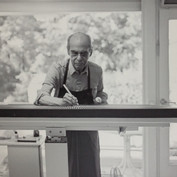Almir Mavignier

Rio de Janeiro, Brazil, 1925 —
Hamburg, German, 2018
Almir Mavigner’s trajectory intercepts the main artistic and social contexts that fostered Brazilian Concretism, such as research on art by psychiatric patients, contact with the School of Ulm and the relationship with graphic design, as a way of inserting art in everyday life.
The artist was directly involved in organizing the 1947 and 1949 exhibitions with works produced by Dr. Nise da Silveira’s psychiatric patients and was one of the first artists to incorporate the results of the study on Geltalt developed by the critic Mário Pedrosa into his production, with whom Mavignier participated in the first abstract art group in Rio de Janeiro, along with Ivan Serpa and Abraham Palatinik. He studied in Paris and Germany, where he took classes with Max Bense and Josef Albers at the Form Superior School in Ulm, and maintained contact with Max Bill.
Along this path, Mavignier came to paintings that explore the pictorial field as a unit of pure sensory impact, aligned with op art, exhibited at the Documenta and the 1964 Venice Biennale, and in the exhibition The Responsive Eye, at Moma-NY in 1965. Almir Mavignier, like other important artists of Brazilian concretism, conducted in parallel to his artistic career a sophisticated production in the area of graphic design.
Exhibition "Line, Color and Movement"
We present Line, Color and Movement. Dan Galeria's new online collection exhibition.
